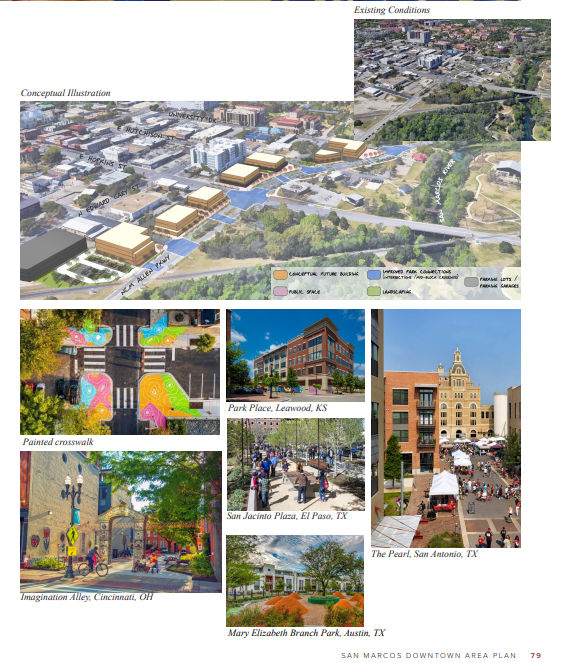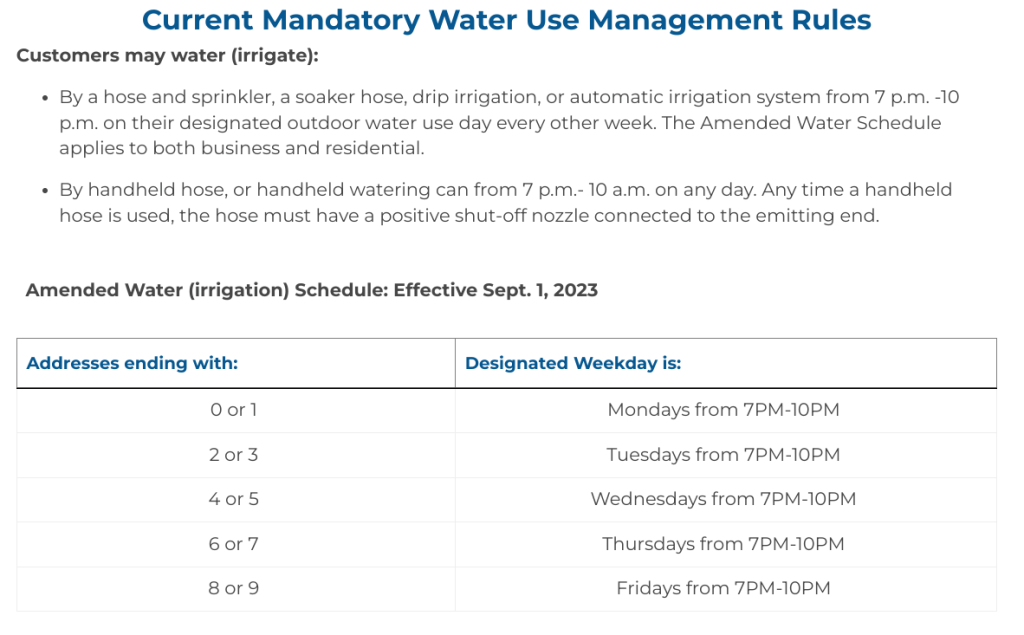VisionSMTX Survey can be found here. Survey is open until Friday, February 23rd.
CHEAT SHEET OPTION 1: The 30-second version:
1. Go here.
2. Click the blue circle on the left that says “Vision SMTX Poll”
3. Select “Original Draft Plan” and submit.
CHEAT SHEET OPTIONS 2 and 3: The 5-minute version and 30-minute version
Should you trust me? Only if you agree with me! Here’s my basic position:
- I do not like economic segregation. Most of the P&Z edits were made to ensure that the only people who live in quiet, residential neighborhoods are people who can afford to rent or own an entire house. I would like small-scale rentals in quiet neighborhoods. The best ways to do this are with Accessory Dwelling Units (ADUs) and little 2, 3, or 4-plexes. You can make them look like houses, even!
- I do not like traffic and pollution. People drive less if there are stores and amenities within easy walking or biking distance. Everyone on the east side of 35 has been asking for more commerce for YEARS and YEARS.
A small neighborhood grocery store and restaurant doesn’t fit in the 1980s Suburbs Dream, but can’t we move past that? Wouldn’t it be nice to easily pick up a pack of diapers or some dog food?
- I do not like sprawl. The changes above – small-scale rentals and nearby commerce – are both examples of “gentle densification”. The Historic district is the best example of what the goal is.
Sprawl makes for higher taxes, because the city has to cover a very large footprint with utilities, SMPD, and firefighters. Sprawl is expensive and unsustainable. Gentle densification is a sustainable solution.
CHEAT SHEET OPTION 2: the quick version, the biggest topics
1. Go here.
2. Click the blue circle on the left that says “Vision SMTX Poll”
3. Select “Original Draft Plan”
4. In the first comment box, cut and paste the following recommended language:
Topic: Commerce and amenities close to residences (complete communities)
Recommended language: “Please change items #13, 14, 20, 23, 24, 26, 27, 34, 39, 40, 61, 64, 69, 72, 74, and 79 to reflect my preference for having commerce and amenities within walking distance of where people live.”
Topic: Small-scale rentals in quiet neighborhoods
Recommended language: “Please change items #8, 9, 16, 17, 33, 35, 36, 37, 38, 38A, 38B, 66, 72, 74, 79, 81, 87, and 88 to reflect my preference for having compatible, small-scale rentals available in quiet, single family neighborhoods.”
5. Then finish and submit.
CHEAT SHEET OPTION 3: the long version, going item by item.
The two topics above are by far the biggest topics. However, there are a bunch of topics that come up on 1-2 items:
- Environment
- Sprawl/Traffic
- Tenants rights
- Equitable growth
- Biking and trails
- Housing shortage
- Walkability
- Layout of city
Below, I’ve organized the individual items by topic. I started with the smaller topics, and then put all the items from Commerce and amenities close to residences (complete communities) and Small-scale rentals in quiet neighborhoods at the end.
Feel free to cut and paste any of these, as much as you want!
Environment
Item 6: Yes on adopting a dark skies ordinance. This change is good.
Item 19: Yes on language protecting water quality and preserving recharge of groundwater, and protecting environmentally sensitive areas. This change is good.
Item 47: Yes on language about how parking structures allow for less horizontal surface space dedicated to surface parking. Please include “Explore other ways to reduce the horizontal surface space dedicated to surface parking.”
Sprawl/Traffic
Item 20: Remove “vehicle trip” from first bullet point about 15-minute travel time
Item 45: Revert to original. Put language back in about the drawbacks of existing mixed use low areas.
Item 56: Restore 2nd sentence, about how San Marcos would have housing demands outpacing employment growth under the alternative scenario.
Item 78: Yes on the new language, giving the impact of sprawl on police response times and travel times.
Item 91: Restore definition of Transit Oriented Development
Item 92: Restore definition of Transit Supportive Development
Tenants rights
Item 10: Yes on initiatives to promote programs and provide education on tenant rights and responsibilities.
Equitable growth
Item 21: Put “equitable” back in the sentence where it was removed. (“Provide access to parks” back to “Provide equitable access to parks…”)
Item 27: Restore sentence about the problems of incomplete communities.
Item 28: Restore the clause “and promote a more equitable distribution of mixed use places”
Item 80: This definition is terrible. It uses the word “equitable” but whoever wrote it is not clear on what “equitable” means. Specifically, this definition implies that the goal for equitable growth is to treat everyone equally. This should be scrapped, and the original definition of “equitable” from Item 82 should be restored.
Item 82: Restore the definition of “equitable”.
Biking and trails
Item 21: Restore the phrase “and to encourage active transportation” to the first sentence.
Housing shortage
Item 58: Restore the 2nd sentence, about how higher intensity areas will accommodate a lot of housing and employment needs.
Walkability
Item 20: Remove “vehicle trip” from first bullet point about 15-minute travel time
Item 59: Restore first sentence, about ensuring a high level of walkability with places to walk near most residences.
Layout of city
Item 62: Restore map images – they are helpful for at least some of us.
Item 93: Yes on edits – keep Guadalupe and LBJ as 1-way streets.
The two big topics:
Topic: Commerce and amenities close to residences (complete communities)
Item 13: Revert to original, stronger language.
Item 14: Change “Consider” back to “Allow”.
Item 20: Remove “vehicle trip” from first bullet point about 15-minute travel time
Item 23: Restore “investments and” to the first sentence. Restore the last sentence about complete places and communities.
Item 24: Restore two sentences.
Item 26: Restore first and second sentences to the original. (Edits to 4th sentence are fine.)
Item 27: Restore description of incomplete communities.
Item 34: Restore “To achieve the goal of truly Complete Communities, …”
Item 39: Restore description of Neighbohood Medium Place Type. I don’t see anywhere else with a description this useful.
Item 40: Restore ADUs to Primary Land Use.
Item 59: Restore first sentence, about ensuring a high level of walkability with places to walk near most residences.
Item 61: Restore the deleted clause about complete communities.
Item 64: Restore “and residential”, “that are walkable”, “in or”, and “They should be concentrated to small geographies and distributed throughout the city”.
Item 69: Restore the last deleted clause, “that will contribute to creating more complete communities throughout San Marcos”.
Item 72: Restore the bullet about implementing VisionSMTX goals and policies on a neighborhood scale. Allowing neighborhood plans to shut down city goals can cause NIMBY collective-action problems.
Item 74: Restore the original final sentence on Area Plans.
Item 79: This is a useful definition to include, but there is no definition of 15-minute cities in this table. Include a conventional definition of 15-minute cities, using walking or biking but not vehicles.
Small-scale rentals in quiet neighborhoods
Item 8: Revert 2nd, 3rd, and 4th paragraphs back to original form.
Item 9: Re-included HN 2.2, and restore original language for HN 2.3 and HN 2.4.
Item 16: Keep “and incentivize” and “to accessory dwelling units”. (The edit adding “micro homes” is fine.) Delete the last sentence – I do not want neighborhoods to be able to prevent affordable small-scale housing options from being located in them.
Item 17: The new sentence will be fine if the following language is included: “but this shall not be interpreted to infringe on whether compatible infill can be subdivided into smaller, more affordable units.”
Item 33: Re-include sentence about small scale multiplex and ADUs.
Item 35: the short descriptions are fine, but should not replace the more meaningful descriptions of place types in items 38,38A, 38B, 39, 41, 43, 44, 45, 49, 51, and 53. Please restore originals in those items.
Item 36: Area Plans and Neighborhood Character Studies should not be allowed to prevent affordable small-scale housing options from being located in them. Large-scale, yes. Requiring a compatible exterior is also fine. But not effectively prohibiting them altogether.
Item 37: Graphics for Nbd Low-Existing should include ADUs and small-scale rentals, of the kind of example that exists in the Historic District currently.
Item 38: Include ADUs and small-scale multifamily in Neighborhood Low-Existing.
Item 38A: The deleted paragraph for the old Nbd-Low should be used for Nbd-Low-Existing. The new writing in 38A should be deleted. Small multiplexes should be included under secondary land uses.
Item 38B: Since this is just for new neighborhoods, please be more assertive with what we would like developers to build. Suggested language to insert: “San Marcos recognizes the damage caused by single-family sprawl. New residential neighborhoods should not be homogenous single-family products. Developers should include gentle densification and economic integration by including small scale rental options intermixed with traditional homes. Commerce should also be planned within a 15-minute walk or bike from homes.”
Item 66: Delete this sentence. Instead include, “The single-family nature of traditional neighborhoods was designed to exclude based on race and/or wealth. Renters should have opportunities to live and raise children in quiet neighborhoods. Small-scale rentals can add opportunities for affordable housing, while preserving the quiet nature of traditional single-family neighborhoods.”
Item 72: Restore the bullet about implementing VisionSMTX goals and policies on a neighborhood scale. I do not want neighborhoods to be able to prevent affordable small-scale housing options from being located in them. Allowing neighborhood plans to shut down city goals can cause NIMBY collective-action problems.
Item 74: Restore the original final sentence on Area Plans.
Item 81: Restore the definition of Cottage Cluster. These are great affordable options for renters, especially with children.
Item 87: Restore definition of Middle Density
Item 88: Restore definition of Missing Middle Housing


















